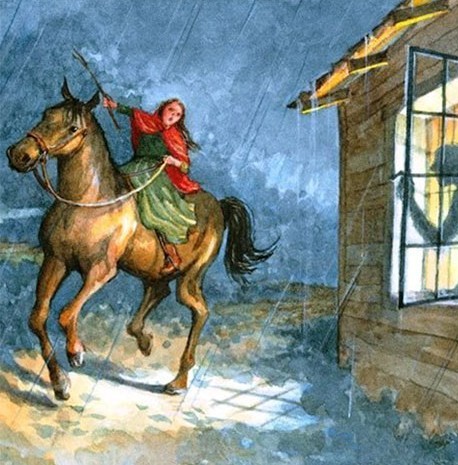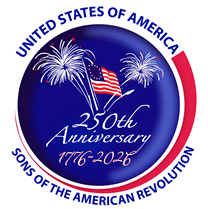By David A. Welker, SMJC Chapter Historian
Legend, Virginia official declarations, a children’s’ book, even a recent SAR-dedicated historic sign tell the story of Susanna Bolling’s famous 1781 nighttime ride to warn the Marquis de Lafayette of British plans to seize him, preventing events that may have altered the war’s course and potentially threatened American independence itself. Susanna’s actions earned her the titles “Revolutionary War heroine” and “the girl who saved the Revolution.” But did this heroic event really happen?

Susanna Bolling was born on December 5, 1764, in the village of City Point, now known as Hopewell, in Prince George County, Virginia to Alexander Bolling (1721 – 1766) and Susanna Bolling (1728 – 1788).
During the Revolutionary War, 16-year-old Susanna Bolling lived in her family’s plantation near City Point, Virginia. According to legend, in late May 1781, British General Lord Charles Cornwallis and his British Southern Army arrived unexpectedly on the plantation, where it set up camp and Cornwallis and his staff moved into the family’s house. One evening, Susanna Bolling overheard Cornwallis’s plan to capture the Marquis de Lafayette, the French nobleman who served as an American general and key Patriot ally. The legend continues that during the night, after learning this intelligence, Susanna Bolling snuck out of her home through a secret underground tunnel, crossed the Appomattox River in a canoe, then borrowed a neighbor’s horse to ride to the Half Way House, where Lafayette had his headquarters. There she warned General Lafayette of General Cornwallis’s plan to capture him.
Armed with Susanna Bolling’s information, Lafayette was able to frustrate Cornwallis’s plan and continue carrying out his vital part of General George Washington’s orders to ensure Cornwallis’s British Army remained in Yorktown, Virginia while Washington’s American Army and French allied troops commanded by the Comte de Rochambeau traveled south to besiege them. This plan in October 1781 led to the Siege of Yorktown, Cornwallis’s surrender, and ultimately American independence.
After the war, Susanna married Thomas Britton (1776-aft. 1793) on January 3, 1797 in Oglethorpe, Georgia and following his death, married Peter King (abt. 1756 – 1813). She gave birth to five children: Rebecca Ann (King) Cornelison (1777 – 1860), John Wesley King (1782 – 1835), Boling King (1783 – aft. 1860), Levisa (King) Medaris (1790 – 1838), and Cummins King (1796 – 1878). The date of Susanna’s death and her final resting place are unfortunately, unknown.
Her actions have understandably been compared to those of Paul Revere and have recently been given new prominence, as told in the 2018 Teen and Young Adult book Susanna’s Midnight Ride: The Girl Who Won the Revolutionary War (Courageous Women in American History) by Libby Carty McNamee. In 2019, the Commonwealth of Virginia declared each December 5th (Susanna’s birthday) as “Susanna Bolling Day.” The SAR designated Susanna Bolling SAR Patriot #P-347337 and included her in Charles Claghorn’s 1991 book Women Patriots of the American Revolution. SAR’s Richmond Chapter on October 27, 2024 dedicated a sign commemorating her actions near the Half-Way House, the end point of Susanna Bolling’s ride. Built in 1760, the house stands today and operates as the Halfway House Restaurant.
However, some question if Susanna Bolling’s ride actually occurred. Most significantly, no primary source records exist that would verify her tale.
The oldest written account of Susanna Bolling’s ride appears in the 1957 book The Prince George-Hopewell Story by Francis Earle Lutz, which claims: “Lord Cornwallis…re-grouped his forces and prepared to seek out and annihilate “the boy” Lafayette, who was operating on the north side of the James River. In his movement from Petersburg, Cornwallis spent one night at Mitchell’s, the Bolling home, which stood until recently on Mansion Hill in the present [town of] Hopewell. While the enemy officers wined and dined, they discussed freely their objectives and their immediate plan for crossing the James and taking Lafayette from the rear. Paying strict attention to details, according to legend, was young Susanna Bolling. When night came, she quietly crept though a secret underground passage to the Appomattox River, which she crossed, and then made her way overland to the Half-Way House on the present Richmond-Petersburg Turnpike [modern US Rt. 1], where she communicated the British plans to the young French nobleman.” However, no documentation exists to place Lafayette at the Half-Way House (despite Lutz’s and the modern restaurant’s claims) and Lutz’s geography is mistaken – the house is south, not north, of the river.
Moreover, although Lutz claimed as a source for Susanna’s story “the noted British historian, Charles Stedman [who] passes on this legendary act of heroism to posterity,” his 1794 book Origin, Progress, and Termination of the American War never mentions Susanna Bolling or any account resembling the tale of her ride.
On top of that, a 1942 article from “The Hopewell News” by Judge Thomas B. Robertson declares that a friend, not Susanna herself, conducted the ride.
It certainly matters whether Susanna Bolling’s famous ride is an actual event of the Revolution or was concocted by a 20th Century writer, yet baring some new discovery it may not be possible to know the full truth. Given this, it’s important for those of us keeping alive America’s Revolutionary War history in the SAR to honestly and accurate relate information to the public – including such ambiguities and uncertainties. After all, regardless if her ride occurred or not, Patriot civilians like Susanna Bolling and her family made real, substantial contributions that ensured the Revolution’s success. And those deserve to be remembered as much as tales of daring-do.
Sources:
- Susanna’s Midnight Ride: The Girl Who Won the Revolutionary War (Courageous Women in American History) Paperback – June 15, 2018 by Libby Carty McNamee (Author), via Amazon.com [1]
- Virginia, U.S., Extracted Vital Records, 1660-1923, Virginia Vital Records [2] via Ancestry.com shows her birth date and parents.
- The Virginia Magazine of History and Biography [3], Vol. 23, No. 4 (Oct., 1915), pp. 422-423 show her birth date as December 5, 1764 to parents Alexander Bolling and Susanna Bolling; it also shows the birth dates and marriage date of her parents.
- “Mitchell’s, Bolling Home, Described,” The Hopewell News, 1942, https://storymaps.arcgis.com/stories/a1095c64e5ac45a59ef6a20a7183d45e
- Joint Resolution 649 Bill Text: VA HJR649, that “Designating December 5, in 2019 and in each succeeding year, as Susanna Bolling Day in Virginia.”

